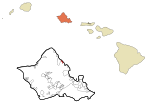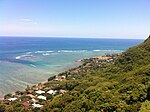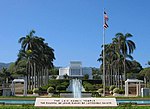Sacred Falls State Park

Sacred Falls State Park (traditionally named Kaliuwaʻa in Hawaiian) is a closed state park located in Hauʻula on the North Shore of the Hawaiian island of Oʻahu. It has been closed since the rockfall that occurred on Mother's Day in 1999. Although people caught entering the park are subject to hefty fines, hikers continue to trespass into the park. The park encompasses Kaluanui gulch and the waterfalls at its end. It is a wahi pana in the district (moku) of Koʻolauloa, with much associated Hawaiian lore: "Kaliuwaa (sic) is the most famous of all the valleys in the district of Koolauloa."According to Hawaiian beliefs, visitors were encouraged to lay leaves and place stones on them, as they entered the valley, gorge, and falls to show respect to the demigod associated with the location.
Excerpt from the Wikipedia article Sacred Falls State Park (License: CC BY-SA 3.0, Authors, Images).Sacred Falls State Park
Geographical coordinates (GPS) Address Nearby Places Show on map
Geographical coordinates (GPS)
| Latitude | Longitude |
|---|---|
| N 21.573333333333 ° | E -157.91416666667 ° |
Address
Honolulu County
Hawaii, United States
Open on Google Maps









